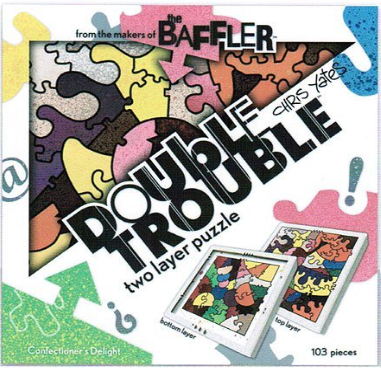 |
| Double Trouble - Double layer jigsaw puzzle and brainteaser |
When it comes to jigsaw puzzles, there is a fine line between fun and frustration for me. I assemble them to relax and I choose pictures that are calm and soothing, often whimsical nature scenes. The most recent puzzle I picked up was a 1,000 piece Ravensburger (what else?) picturing a large bookcase loaded with books with punny titles and whimsical animals and knick-knacks. There has to be a lot of detail, colors, and patterns to keep it light. I am not really looking for a challenge in a jigsaw puzzle. My sister on the other hand, has assembled a solid yellow puzzle (Banana) and a picture of nothing but needles and one piece of hay (Hay in a Needle Stack). Those kind of puzzles would drive me bonkers.
This puzzle quickly fell into the frustration category for me. The difficulty meter on the back of the box says that it is half way between Uh-Oh and Whoa Nelly! Still, with only 103 pieces total for 2 puzzles (it is two layers), how hard can it be? So I took apart the top layer and went to work. Twenty minutes ticked by and I had about 10 pieces in place. The back of the box did warn "Each puzzle is randomly designed and cut in the oddest ways to make it as tricky as possible." It's all about the shape and a little about the color, as there are small color groupings. But since it doesn't really make a scene that I can tell, except for a few ice cream cones, it's hard to know where the color groupings stop and other colors pick up. I was afraid to take apart the bottom layer, figuring I would never get it back together, until I realized that the solution is printed several places on and in the box. Maybe I should have gone into this thinking of it as a general brainteaser type puzzle, rather than a jigsaw puzzle. Maybe I'll pull it back out later and go at it from that angle. That could be fun.
I've blogged a lot about different types of jigsaw puzzles and how to help kids learn to assemble them. Click on this link to read my post Tips for Assembling Jigsaw Puzzles.
Try this:
- Let the individual use the picture on the box as a pattern if assembling it without would be too challenging.
- Ask the individual to pick up each piece and turn it in-hand to orient it correctly.
- Narrow possible confusion and lead the direction the person works by giving him only two or three pieces at a time to assemble.
- Continually remind the individual "It's made to be difficult" if frustration rears its ugly head.
- Work on fine motor skills, figure ground, visual closure, problem solving, play and leisure exploration and participation, process skills
In the box: 103 pieces, square puzzle board to build on.
Ages 12+
If you are interested in purchasing this item or just want more information, click on the image below.




No comments:
Post a Comment
Thank you for taking the time to comment.